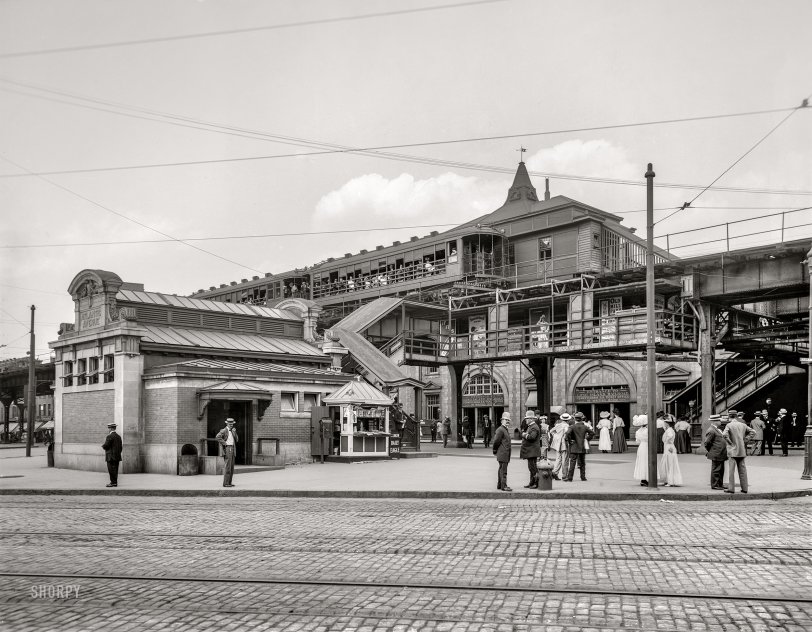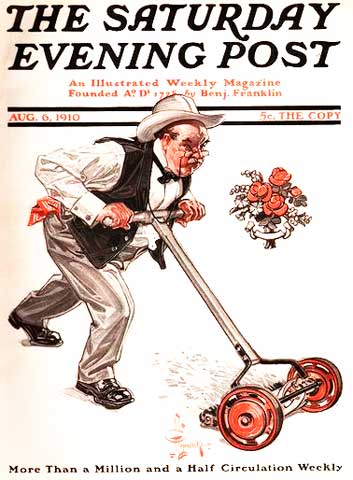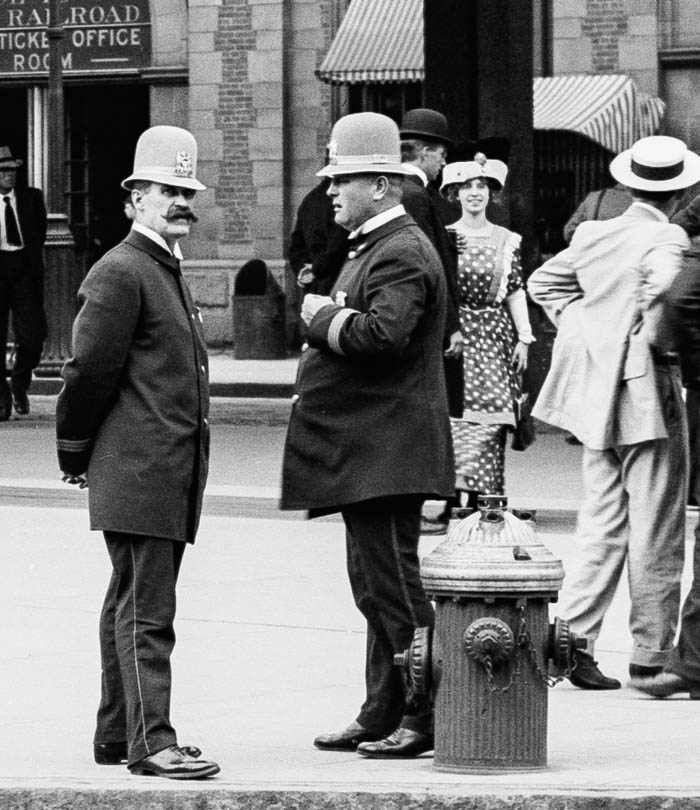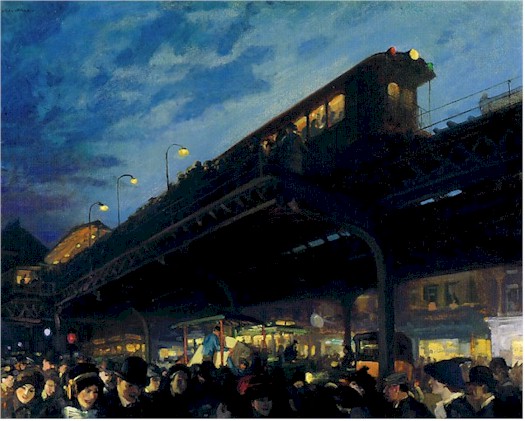


Framed or unframed, desk size to sofa size, printed by us in Arizona and Alabama since 2007. Explore now.
Shorpy is funded by you. Patreon contributors get an ad-free experience.
Learn more.

- Lofty addition
- In 1912
- Keenan Building
- Six years old
- Taken from the P.J. McArdle Roadway?
- It stood only 47 years
- Three track mind
- Incline to the right
- Reach for the sky, 1912 style
- No clean sweep
- Same Job Title, Same Face
- Sadly Lost
- Beautiful ...
- Where you get your kicks
- Aim High
- Pueblo Revival sisters
- Pueblo Neoclassicism
- Milk Man
- Regional dialect.
- Spielberg's inspiration
- Great Photo
- Loaf Story
- Do you still have the Rakes category?
- Could almost be a scene from the 1957 movie 'Hell Drivers'
- The Wages of Fear.
- Conspicuous by their absence
- Got Milk?
- All that aluminum
- No lefties
- Smoke 'em if you've got 'em
Print Emporium
Mass Transit: 1910

A better-quality version of an image first posted here in 2008.
Brooklyn, N.Y., circa 1910. "Atlantic Avenue subway entrance." Plus an elevated railway and streetcar tracks. 8x10 inch dry plate glass negative, Detroit Publishing Co. View full size.
About the policemen's hats
According to the Internet (so it must be true), the New York City police wore "custodian helmets," grey for summer and blue for winter, from 1880 to 1912.
Famous time travelers caught on glass
Now it can be told: many celebrities were also, in fact, secret travelers through time. Although I am not at liberty to disclose their methods, I am permitted to point out a few well known faces.
On the far left, we see W.C. Fields, wearing false whiskers, attempting to look casual. Moving right, we see a stylish Brian Donlevy striking a pose as he boldly looks directly at the camera. Just behind the policeman on the right is a young Gary Cooper, who is not quite as tall as he would be later in life. The young lady in the au courant outfit is lovely Laura La Plante. And now we come to the true master of time travel, Charles Durning, who is both the policeman on the right *and* the man in the white hat, on the other side of the pole, with his back to his policeman self.
Take the "A" train.
Unlike the other els mentioned, the Fulton Street el (in the picture) had been replaced by a subway before being torn down. Through service to Manhattan at last.
Yes, the "A" train.
My old stomping grounds
Before my transfer to Garden City. View of the same location October 2018. By the way the Brooklyn Daily Eagle is archived for free online access: https://bklyn.newspapers.com/
"Circa 1910" indeed
There's no "circa" about it given that the "3 Eagles" newsstand is displaying the Aug 6, 1910, issues of The Saturday Evening Post .

Fashion Forward
The lovely lady in the polka dot dress must just have gotten back from Paris, as she is wearing the latest Paul Poiret inspired hobble skirt/pagoda tunic, with a Japanese- bridal style hat. All of the other ladies in the photo, with full flared skirts, blousson bodices, and huge, but very lightweight picture hats will be following her style by next Spring, at the latest.
Polka dots and moonbeams
I'd love to make the acquaintance of the lovely lady in polka dots. And, check out the lady's amazing hat!

A nicer time
I live not far from here, and this photo is so much nicer than what it is today -- a mall with trash and insane traffic. Makes me wish I was there back in 1910.
Open platform El cars
After the Malbone Street wreck in 1918, wooden cars were banned from the subways. Open-platform wooden cars continued to be used on the Els in Brooklyn until 1958, when the last of the "BU" El cars ran on Myrtle Avenue. The IRT ran wood open platform El cars in Manhattan and the Bronx until the early 1950s. In 1938 the "Q" class El cars had steel ends added to enclose the open platforms of 1903 wood El cars; they were used on the Flushing line for the 1939 World's Fair. After that the "Q" cars ran on the Third Avenue El in Manhattan and the Bronx before finishing out their days on Myrtle Avenue in 1969. Open platform El cars were typical of rapid transit from the 1870s through the mid teens. They were labor intensive, with a conductor needed between every two cars.
Ashcan school
The Ashcan school of artists was known for painting New York street scenes similar to this. John Sloan's famous and, in this writer's opinion, beautiful painting, Six O'Clock, Winter, painted in 1912, may have been painted at this station or a similar one in the city.

Atlantic Avenue
The subway entrance is still there, but it's no longer in use as such. The MTA renovated it when it expanded and refurbished the Atlantic Avenue subway station, but because the entrance is on a traffic island in the middle of a very busy intersection, you can no longer use it to enter the station. Instead, it now serves as a skylight for the underground station.
There's a spot in the station where you can stand about 20 or 30 feet underneath the old station house, look up, and see it directly above you, hollowed out and streaming light into the station. If I still lived in Brooklyn, I'd get a photo.
You can see it here, photographed from Flatbush Avenue:
The mall that 9:26 AT refers to you would be behind you in this shot. I tried to get a Google Map image from the vantage point of the 1910 photo, but a large truck was between the Google Map camera and the old station entrance. I believe the 1910 image was photographed from roughly where the PC Richard currently stands.
There's a much better view of the current state of the old entrance here, in a photo from April of this year: http://www.nycsubway.org/perl/show?82823
You can also see it, boarded over and in disrepair, in this 1997 photo: http://www.nycsubway.org/perl/show?426
Finally, the New York Times has a good article from 2003 about the renovation of the Atlantic Avenue station, including a couple of paragraphs about the old station house. I used the station daily during the renovation, and the work they did was remarkable.
To El and Back
June 1, 1940, was when the City of New York took over the trolleys, elevated railways and subways of the BMT and began the abandonments. The Fifth Avenue El, the Fulton Street El, Fulton Street trolleys, Gates Avenue trolleys and Putnam Halsey cars ran their last on May 30. Both Els were torn down the summer of 1941.
NYC Transit
I used to ride these cars as a kid. The transportation system in NYC was so far superior before 1940, at a nickel a pop for over 40 years, that people today cannot even imagine how easily, safely, and pleasantly it was back then.
Love the open-sided subway cars!
Can we assume these cars ran aboveground at all times? You couldn't go underground in these cars. Or you could.....but you'd need hosing down at the end of the ride.
Then and Now
The tracks are gone and the Long Island RR Building in the back was transformed into a mall. The small building on the Island that says "Atlantic Avenue" is still there. My son lives around the corner. I'll take a picture and post it for everyone to see.
Breezy
I would think that those open-sided cars get a little breezy.
Still Standing
The subway entrance in the foreground is still there. The elevated and the railroad terminal building are not. The Atlantic Avenue-Pacific Street subway station is home to (If I remember correctly) nine subway lines. The LIRR still has its terminus at Flatbush Avenue. Because of the great mass transit, this is the site where the NJ Nets are building their new arena.
The surface traffic is horrendous now. That's why the neighborhood is pretty much against building the arena.
Rock and Fulton
Looks like the poster for the Brighton Beach Music Hall (which later became a Yiddish theater) is advertising William Rock and Maude Fulton. They were apparently heading the bill written about here in the Aug. 7, 1910, New York Times.
























On Shorpy:
Today’s Top 5